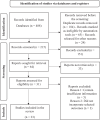Efficacy of botulinum toxin in the treatment of chronic anal fissure: a comprehensive systematic review
- PMID: 40787502
- PMCID: PMC12333800
- DOI: 10.1097/MS9.0000000000003471
Efficacy of botulinum toxin in the treatment of chronic anal fissure: a comprehensive systematic review
Abstract
Acute anal fissure maintains a debilitating state that produces enduring wound damage on the anal mucosa while the internal anal sphincter demonstrates increased muscle tone. This study aims to conduct a comprehensive systematic review to evaluate the efficacy of botulinum toxin (BT) in the treatment of chronic anal fissure, synthesizing current evidence from clinical trials and observational studies to guide evidence-based practice. A review of systematic research investigates the performance and security along with extended outcomes linked to BT therapy for treating chronic anal fissure by analyzing 23 clinical studies. The healing response from BT injections reaches 60%-85% without producing headache side effects commonly experienced with topical glyceryl trinitrate (GTN) medications. Lateral internal sphincterotomy (LIS) produces excellent long-term healing results in 90%-95% of cases, although it leads to fecal incontinence risks at a 5%-15% rate. Expanding BT treatment usually necessitates additional injections or surgical intervention because of its high rate of recurrence over 1-3 years (30%-40%). Combining Botox treatment with GTN administration achieves healing rates between 70% and 80%, but studies provide inconsistent research data. The optimal dosage range for BT treatment is 20-30 units, while Botox performs equally well as Dysport in achieving these results. BT provides patients who do not want surgery the benefit of being a safe, minimally invasive procedure. At the same time, LIS offers a definitive solution for patients who cannot respond to other treatments. Research must establish standardized dose instructions while improving injection methods and developing extended strategies to stop relapses.
Keywords: anal fissure; botulinum toxin; diarrhea; nitroglycerin; recovery; recurrence; sphincterotomy.
Copyright © 2025 The Author(s). Published by Wolters Kluwer Health, Inc.
Conflict of interest statement
Sponsorships or competing interests that may be relevant to content are disclosed at the end of this article. The authors declare that they have no known competing financial interests or personal relationships that could have appeared to influence the work reported in this paper.
Figures
Similar articles
-
A systematic review and meta-analysis of the treatment of anal fissure.Tech Coloproctol. 2017 Aug;21(8):605-625. doi: 10.1007/s10151-017-1664-2. Epub 2017 Aug 9. Tech Coloproctol. 2017. PMID: 28795245
-
Non surgical therapy for anal fissure.Cochrane Database Syst Rev. 2012 Feb 15;2012(2):CD003431. doi: 10.1002/14651858.CD003431.pub3. Cochrane Database Syst Rev. 2012. PMID: 22336789 Free PMC article.
-
Comparison of doses and injection sites of botulinum toxin for chronic anal fissure: A systematic review and network meta-analysis of randomized controlled trials.Int J Surg. 2022 Aug;104:106798. doi: 10.1016/j.ijsu.2022.106798. Epub 2022 Aug 5. Int J Surg. 2022. PMID: 35934283
-
Non surgical therapy for anal fissure.Cochrane Database Syst Rev. 2003;(4):CD003431. doi: 10.1002/14651858.CD003431. Cochrane Database Syst Rev. 2003. Update in: Cochrane Database Syst Rev. 2006 Oct 18;(4):CD003431. doi: 10.1002/14651858.CD003431.pub2. PMID: 14583976 Updated.
-
Botulinum toxin and anal fissure: efficacy and safety systematic review.Int J Colorectal Dis. 2012 Jan;27(1):1-9. doi: 10.1007/s00384-011-1286-5. Epub 2011 Aug 6. Int J Colorectal Dis. 2012. PMID: 21822595
References
-
- Higuero T. Update on the management of anal fissure. J Visc Surg 2015;152:S37–43. - PubMed
LinkOut - more resources
Full Text Sources

